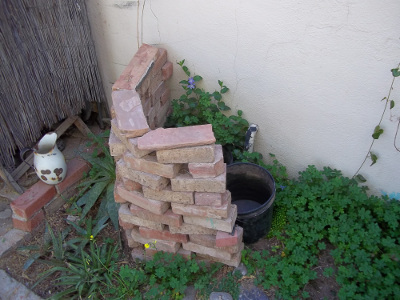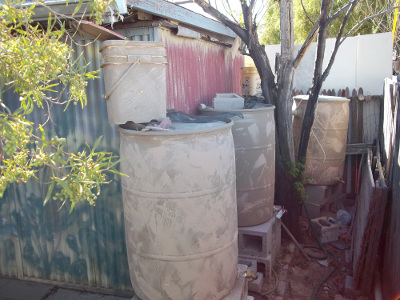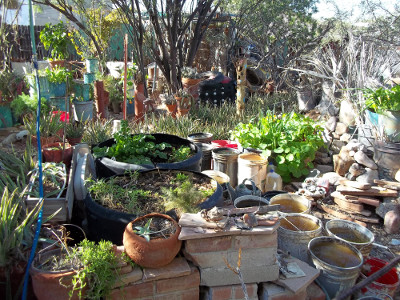WATER HARVESTING
PASSIVE
In the 80's I began with passive water harvesting by building berms and hills on my clay art studio property to direct rain water to newly planted trees and shrubs and prevent rain water from running off my property down the street. So much technology, like landscape design, isn't designed for the desert. I want to keep the rain that falls on my property soaking in deeply to grow my native trees that give me cooling shade; and I wanted to save water and the labor of watering. Most home developments or custom home landscaping is designed to run off all rainfall rainfall to the street which is a suitable design for wet climates with basements, but not Tucson AZ, where every drop of rain is precious.
I caught rain off of a shed roof in buckets and enjoyed the musical percussion of dripping water in buckets before I installed gutters with rain barrels. Now I fantasize about making a musical rain harvesting bucket system on my current porch.
When I'm waiting for hot water at the sink or shower I run the tepid water in a bucket and use it for house plants, pets, hand laundry or or my water filter. perfectly good water does not run down my drain just because it's the “wrong” temp.
I installed an outdoor bath tub for bathing or relaxing, that drains into the garden. In the summer I cool off in that tub several times a day, it's so relaxing in a tub rather than an outdoor shower, and I rinse my garden clothes off in the tub at the end of the day, then drain the tub in a nearby garden.
My clothes washer sits outside on a patio, I lined up six five gallon buckets and I toted laundry water (greywater) in 5 gallon buckets, both soapy and rinse water, to my landscape plants. In 2022 after 35 years of toting laundry greywater I dug a laundry greywater basin and planted native plants including grasses and a fig tree with a little help from my friends with jack hammers and young muscle. I realize my household doesn't generate enough laundry water to keep that fig happy. I'm giving the fig tree water from my large cistern installed at the studio property that replaced the six 55 gallon rain barrels in 2020.
I keep my gardens small, just enough for myself and a few guests. Growing lots of vegetables I can't use wastes water.When our winter rains are over 4“ and our summer rains are over 4“ my citrus pomegranate and fig tree receive rain water, when rains are not generous I use greywater for my trees and save rain water for my vegetable gardens.
AGGRESSIVE
When I first started growing vegetables in the 1980s when I lived at my Clay Art Studio and tiny house, I installed six 55 gallon rain barrels and lots of buckets under porches for my additional water needs. The total roof space is less than 1,000 square feet at my studio/home. Currently I have two cisterns of 15,000 gallons on my residential property and two smaller cisterns of 1,350 and 1,000 gallons on the studio property. Four of the 55 gallon rain barrels serve to catch the first overflow from the larger cisterns and I use the other two 55 gallon rain barrels to catch rain from porches and sheds. I added three more decorative rain barrels for my awning and porch at my new house.
Folks think making sustainable adjustments to our life style requires lots of money, but I've found I can do most of the work with reclaimed materials with little expense, only upgrading when need/function requires. I did splurge and hire a fellow to add connectors and hose outlets to the six 55 gallon rain barrels. My rain barrels are 55 gallon plastic kegs from soft drink companies or car washes and were several colors. A few years ago Habitat for Humanity sponsored a fundraiser selling artist painted rain barrels. I painted a rain barrel to look like a stone well. I enjoyed 40 hours painting faux rocks. That rain barrel was beautiful and earned Habitat money, but for my rain barrels which weren't visible from my studio patio or yard, I invited my two best friends, Jim and Paul over to help me paint. We slapped on primer and a few layers of tan and beige paint in a textured neutral pattern that blends with my studio.
I make my own system of a first flush to keep fine dirt out of my cisterns. I use 3 gallon cat litter buckets with an upside down clay pot in the bottom of the bucket and an upright clay pot top of the upside down pot. I direct the down spout inside the 3 gallon bucket. The first few gallons of rain water with dust settle to the bottom of the bucket, the two pots prevent the continuing rain water from agitating the water and dust in the bottom of the bucket. When the bucket is full the rain water pours out of a slot cut in the top of the bucket into the top hole of the 55 gallon rain barrel. A piece of screen over the hole in the top of the barrel keeps the leaves out of the rain barrels or cisterns as well as keeping mosquitoes out. Of course the cat litter buckets are painted to match the 55 gallon barrels. Any bucket would work fine. I use the cat litter buckets cause they have a bottom edge that interlocks with the rim of the rain barrel and the plastic handles of those buckets seem to always break making the bucket not as useful in the yard and garden as wire handled buckets.


